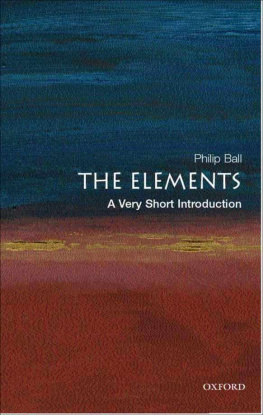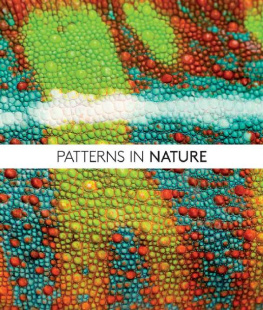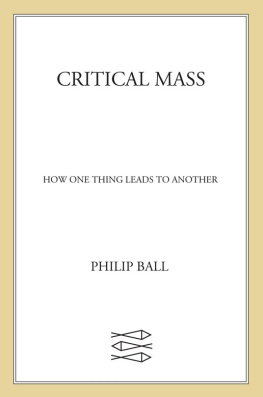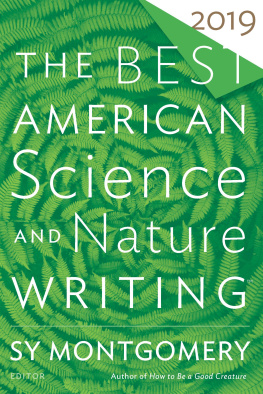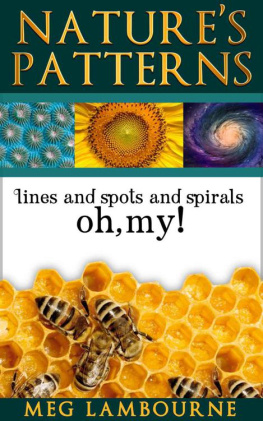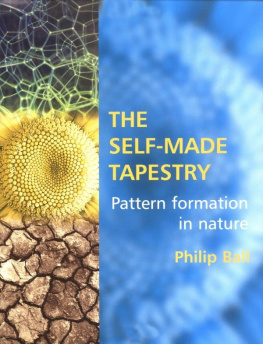NATURES PATTERNS
Philip Ball is a science writer, and the author of many popular science books including H2O: A Biography of Water, Bright Earth, Critical Mass (winner of the 2005 Aventis Prize for Science Books) and The Music Instinct. He lectures widely and has contributed to magazines and newspapers, including Nature, New Scientist, The Guardian, and The New York Times.

Great Clarendon Street, Oxford OX2 6DP
Oxford University Press is a department of the University of Oxford.
It furthers the Universitys objective of excellence in research, scholarship,
and education by publishing worldwide in
Oxford New York
Auckland Cape Town Dar es Salaam Hong Kong Karachi
Kuala Lumpur Madrid Melbourne Mexico City Nairobi
New Delhi Shanghai Taipei Toronto
With offices in
Argentina Austria Brazil Chile Czech Republic France Greece
Guatemala Hungary Italy Japan Poland Portugal Singapore
South Korea Switzerland Thailand Turkey Ukraine Vietnam
Oxford is a registered trade mark of Oxford University Press
in the UK and in certain other countries
Published in the United States
by Oxford University Press Inc., New York
Philip Ball 2009
The moral rights of the author have been asserted
Database right Oxford University Press (maker)
First published 2009
Published in paperback 2011
All rights reserved. No part of this publication may be reproduced,
stored in a retrieval system, or transmitted, in any form or by any means,
without the prior permission in writing of Oxford University Press,
or as expressly permitted by law, or under terms agreed with the appropriate
reprographics rights organization. Enquiries concerning reproduction
outside the scope of the above should be sent to the Rights Department,
Oxford University Press, at the address above
You must not circulate this book in any other binding or cover
and you must impose the same condition on any acquirer
British Library Cataloguing in Publication Data
Data available
Library of Congress Cataloging in Publication Data
Data available
Typeset by SPI Publisher Services, Pondicherry, India
Printed in Great Britain
on acid-free paper by
Clays Ltd., St Ives plc
ISBN 978-0-19-923798-2
1 3 5 7 9 10 8 6 4 2
BRANCHING
Seeing the splayed, forking channels of rivers, natural philosophers were reminded of veins and arteries. These in turn speak of treesand why not, for all are networks that distribute vital fluids. What are the rules that make branches? Why does a lightning bolt seek many routes from heaven to earth, or a crack begin to wander and divide? Branching forms find a compromise between disorder and determinism: they hint at a new and peculiar geometry. Yet sometimes order reasserts itself, as when the arms of snowflakes insist on their hexagonality. And if branches reunite, the loops form a web that offers many routes to the same destination. Navigation and dissemination on such networks then depends on the pattern of connections.
CONTENTS
THE SIX-POINTED SNOWFLAKE
SHAPES BETWEEN DIMENSIONS
CLEAN BREAKS AND RAGGED RUPTURES
LABYRINTHS IN THE LANDSCAPE
BRANCHES IN BIOLOGY
WHY WERE ALL IN THIS TOGETHER
PRINCIPLES OF PATTERN
PREFACE AND ACKNOWLEDGEMENTS
After my 1999 book The Self-Made Tapestry: Pattern Formation in Nature went out of print, Id often be contacted by would-be readers asking where they could get hold of a copy. That was how I discovered that copies were changing hands in the used-book market for considerably more than the original cover price. While that was gratifying in its way, I would far rather see the material accessible to anyone who wanted it. So I approached Latha Menon at Oxford University Press to ask about a reprinting. But Latha had something more substantial in mind, and that is how this new trilogy came into being. Quite rightly, Latha perceived that the original Tapestry was neither conceived nor packaged to the best advantage of the material. I hope this format does it more justice.
The suggestion of partitioning the material between three volumes sounded challenging at first, but once I saw how it might be done, I realized that this offered a structure that could bring more thematic organization to the topic. Each volume is self-contained and does not depend on one having read the others, although there is inevitably some cross-referencing. Anyone who has seen The Self-Made Tapestry will find some familiar things here, but also plenty that is new. In adding that material, I have benefited from the great generosity of many scientists who have given images, reprints and suggestions. I am particularly grateful to Sean Carroll, Iain Couzin, and Andrea Rinaldo for critical readings of some of the new text. Latha set me more work than Id perhaps anticipated, but I remain deeply indebted to her for her vision of what these books might become, and her encouragement in making that happen.
Philip Ball
London, October 2007
1
A WINTERS TALE
The Six-Pointed Snowflake
The followers of Pythagoras believed many strange things, among them that one should not eat beans or break bread, should not pluck a garland and should not allow swallows to land on ones roof. They sound like a bunch of crackpot mystics, but in fact Pythagoreanism has, through its influence on Plato, provided a recurrent theme in Western rationalist thought: the idea that the universe is fundamentally geometric, so that all natural phenomena display a harmony based on number and regularity. Pythagoras is said to have discovered the relationship between proportion and musical harmony, reflected in the way that a plucked string divided by simple length ratios produces pleasing musical intervals. The music of the spherescelestial harmonies generated by the heavenly bodies according to the sizes of their orbitsis ultimately a Pythagorean concept.
All things are numbers, said Pythagoras, but it is not easy now to comprehend what he meant by this statement. In some fashion, he believed that integers were building blocks from which the world was constructed. Bertrand Russell is probably imposing too modern a perspective when he interprets the phrase as saying that the world is built up of molecules composed of atoms arranged in various shapes, even if, for Plato, those atoms themselves were geometric: cubes, tetrahedra, and other regular shapes that, he said, account for the empirical properties of the corresponding classical elements. All the same, it seems fair to suppose that a Pythagorean would have been less surprised than we are to find spontaneous regularity of pattern and form in the worldfive-petalled flowers, faceted crystalsbecause he would have envisaged this orderliness to be engraved in the very fabric of creation.
The ancient Greeks were not alone in thinking this way. Chinese scholars of long ago were as devoted to the study of nature and mathematics as any of their Western counterparts, and by all appearances they were rather more observant. It was not until the European Middle Ages that the Aristotelian tradition of studying specific natural phenomena for their own sake began to permeate the Western world, prompting the thirteenth-century Bavarian proto-scientist Albertus Magnus to record the star-shaped form of snowflakes, which can be seen with the naked eye. But the Chinese anticipated him by more than a millennium. Around 135 BCxs, the philosopher Han Ying wrote in his treatise Moral Discourses Illustrating the Han Text of the Book of Songs
Next page



